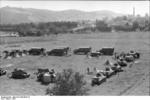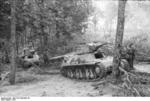H35
| Country | France |
| Manufacturer | Hotchkiss et Cie |
| Primary Role | Light Tank |
Contributor: C. Peter Chen
ww2dbaseThe Char léger modèle 1935 H light tanks, or H35 for short, were designed by the French firm Société Anonyme des Anciens Etablissements Hotchkiss et Cie in 1933 as light and relatively inexpensive tanks to reinforce the French Army. The design was approved on 30 Jun 1933. The specifications finalized and made available on 2 Aug and three prototypes ordered. The first prototype, a turret-less machine gun tankette, was delivered on 18 Jan 1935. The second prototype was delivered on 4 Mar with the same specifications. After the first two prototypes were rejected, the third was delivered on 19 Aug, which had a cast APX turret; it was accepted on 20 Sep. An order for 200 vehicles was issued on 6 Nov and the first was delivered on 12 Sep 1936. Prior to the delivery of the first production vehicle, two additional orders were placed for a total of 200 additional vehicles.
ww2dbaseThe H35 tanks were small vehicles armored by six cast armor plates bolted together, allowing room for only two inside each vehicle. They were difficult to drive, result of weak brakes and fifth gears that was difficult to engage, thus they were handled roughly, causing mechanical unreliability. After field testing, the French Army Infantry accepted only the first 100 H35 vehicles and refused to take further units due to their finding that the H35 light tanks, since they were difficult to drive, handled bumpy terrain unsatisfactorily. The remaining 300 tanks on order were assigned to the Cavalry instead, a division of the Army that used roads more extensively, meaning they had less worry with the issue with bumpy terrain.
ww2dbaseThe French cavalry had two major complaints about the H35 light tanks. First, the armament was weak. To improve the weapon, some of the guns were bored out to accept large shells, but this method was not widely employed as it increased barrel wear. The other issue was the low top speed, which was remedied in 1937 (with ease of drive improved along with it) when larger engines were installed; the new design with the more power engine was accepted on 31 Jan 1939 under the designation Char léger modèle 1935 H modifié 39. On 18 Feb, the new variant design succeeded all original production.
ww2dbaseIn early 1940, some H35 tanks were modernized with radios, and some were equipped with the longer L/35 37-millimeter SA38 guns. In Apr 1940, the newer guns became standard on all H35 light tanks under production.
ww2dbaseIn Feb 1940, two H35 light tanks were export to Turkey.
ww2dbaseWhen the European War began in Sep 1939 with the German invasion of France, 640 H35 light tanks (and variants) were available to the French Army, although only about 500 were in active service in Europe. The start of the war caused the French to plan to expand production, and to aid the French, the British and Portuguese industries were assisting in the production by casting armor sections. The first H35 light tanks saw combat in Poland when three of them, under testing by the Polish Army, were pressed into service on 14 Sep 1939 during the German invasion. 15 of them fought in Norway and participated in the battles at Narvik; 3 were lost during fighting, and the remaining 12 were withdrawn to Britain on 8 Jun and joined the Free French forces in England. By May 1940, at least 1,200 were built, and many of them fought during the defense of France against the German invasion. When France surrendered, about 550 of them were captured by the German forces, which pressed them back into service under the designation Panzerkampfwagen 35H 734(f) and Panzerkampfwagen 38H 735(f); under the German banner, most of them served in occupation roles, though some of them were deployed to Finland during Operation Silver Fox. In 1943, Germany provided Bulgaria 19 H35 light tanks for training purposes, and in 1944 provided 15 to Hungary and a few to Croatia. By Dec 1944, German Army inventory reports show that only about 60 were still in service. In North Africa, 27 H35 light tanks were used against the Allies in Nov 1942, destroying four M3 Stuart tanks, but the French regiment later switched sides.
ww2dbaseAfter WW2, some H35 light tanks remained in active service, mostly with police and other internal security forces in France, Bulgaria, Israel, and others.
ww2dbaseSource: Wikipedia.
Last Major Revision: Oct 2009
SPECIFICATIONS
H35
| Machinery | One 6-cylinder 3,480cc engine rated at 78hp |
| Suspension | Horizontal helical springs |
| Armament | 1x37mm SA 18 gun (100 rounds), 1x7.5mm Reibel machine gun |
| Armor | 40mm turret, 34mm hull |
| Crew | 2 |
| Length | 4.22 m |
| Width | 1.95 m |
| Height | 2.15 m |
| Weight | 11.0 t |
| Speed | 28 km/h |
| Range | 129 km |
Photographs
 |  |  |  |
Did you enjoy this article or find this article helpful? If so, please consider supporting us on Patreon. Even $1 per month will go a long way! Thank you. Share this article with your friends: Stay updated with WW2DB: |
Visitor Submitted Comments
1 Nov 2009 11:41:18 AM
Hotchkiss H-35 was one of three variants of
light tanks delivered to the French Army.
The first production vehicles were issued in
September 1936,with 640 built.
From 1936 onward, two upgraded models the
H-38 and H-39 both vehicles had a more power-ful engine and more armor. During the Battle
of France, many Hotchkiss tanks were lost the
French used their tanks in small infantry support groups, rather than massing in large formations like the Germans did with their
Panzer forces.
With the fall of France,the Germans captured
large amounts of French military equipment
and used them for security duties.
During the war,the Germans rebuilt many into
self-propelled guns.
After W.W.II many of the Hotchkiss vehicles
that served with Vichy forces were abandoned
many were salvaged and used by Middle East armies into the 1950's
1 Nov 2009 12:02:28 PM
The Hotchkiss H-39 was the last variant of
the three models developed during the 1930's
It was fast, but no match against the Panzers. Total production was about 640 for the H-35,with another 890 for both the H-38
and H-39.
During the Battle of France combat between
the Hotchkiss and the Panzers was brief and
one-sided. On May 14,1940 the French lost 11
of its 15 Hotchkiss tanks in a matter of minutes! during a counter-attack on German
forces.
Many captured H-38 and H-39's were used by
the Germans. Later during the war, some were rebuilt into self-propelled guns and also
fitted out as tank destroyers.
Others were used by the Vichy French forces
in Syria.
1 Aug 2010 10:23:41 AM
"Heads In The Sand"
The Germans started to rearm at a faster and
faster pace. The British started to rearm
in 1937.
The French sat behind their Maginot line and
took their time modernizing their forces.
Many of the Generals that fought in the WWI
were now in their late 60's and 70's, they
did not understand how armored warfare could
chage the face of battle.
They still believed the French army could
win the day, against the Germans. It was hard
for many of these old Generals to believe armord forces could travel between 50 to 75
miles a day, where the French Infantryman could march 15 to 20 miles a day.
French had more tanks than the Germans, but they lacked the tactics the older Generals, failed to believed in the younger tank officers.
1 Aug 2010 10:46:46 AM
"Surviving H-35's"
Eight H-35 tanks survive today, most are in
Museums in Europe, Israel and Russia.
The H-The was used by both Israel and other
Middle east countries.
Ten were sold to Israel in 1948, and the last
H-35 was retired from the IDF in 1952.
The H-35's on disply in museums in France and
the tank museuma at Kubinka, Russia are in running condition.
All visitor submitted comments are opinions of those making the submissions and do not reflect views of WW2DB.
- » Wreck of USS Edsall Found (14 Nov 2024)
- » Autumn 2024 Fundraiser (7 Nov 2024)
- » Nobel Peace Prize for the Atomic Bomb Survivors Organization (11 Oct 2024)
- » Wreck of USS Stewart/DD-224 Found (2 Oct 2024)
- » See all news
- » 1,150 biographies
- » 337 events
- » 43,917 timeline entries
- » 1,241 ships
- » 350 aircraft models
- » 207 vehicle models
- » 373 weapon models
- » 123 historical documents
- » 260 facilities
- » 470 book reviews
- » 28,538 photos
- » 432 maps
George Patton, 31 May 1944
Please consider supporting us on Patreon. Even $1 a month will go a long way. Thank you!
Or, please support us by purchasing some WW2DB merchandise at TeeSpring, Thank you!
31 Oct 2009 05:57:31 PM
The Hotchkiss H-35 was a light tank designed
in the late 1930's. By June 1940 1,080 had
been built,all three variants The H-35,H-38
and H-39. The vehicles had small turrets,its two-man crew was restricted and was not very effective.
Armed with one 1.5 inch L/38 cannon and one
coaxial machine gun, the weight of the tank
was around 13.3 tons.
Maxium road speed was 23mph road speed, and
cross-country speed was 10 mph.
After the Battle of France, the Germans
captured large numbers and designated them
Panzerkampfwagen 35,38 and 39. The vehicle was used for different security duties with the occuption forces in France, The Balkins,
Greece and Norway.
Some H-35's were given to Germany's Allies.
Later during the war, the germans rebuilt
some H-35's into self-propelled guns.
Strange bedfellows:
After W.W.II many H-35's and H-39's were sold some to the Israeli Army in 1948, and
others were sold to Jordan and Egypt.